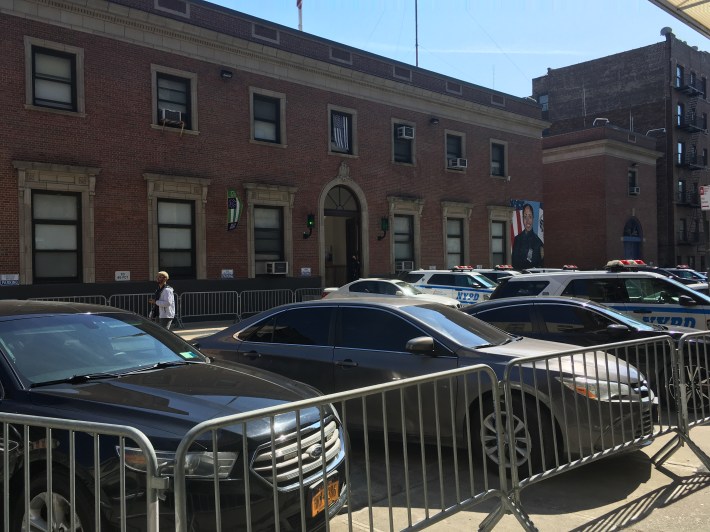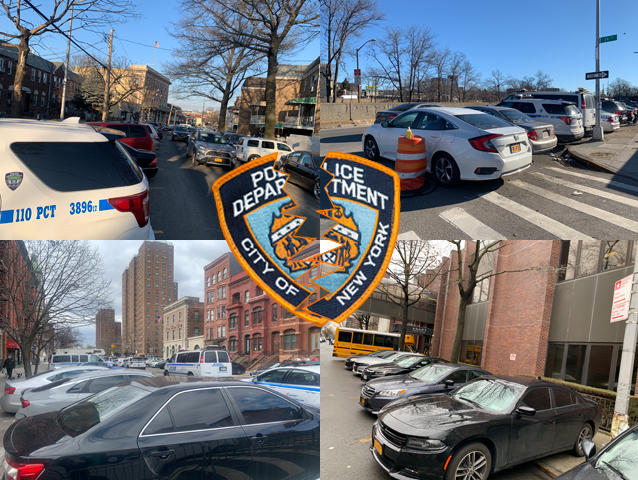One Police Plaza, we have a problem.
Communities all over the city are crying out for relief from the danger and congestion created by all the illegal parking that cops do at local police station houses — the blocking of sidewalks, fire hydrants, bus lanes, crosswalks, bike lanes and other vital infrastructure. That's not simply the view of Streetsblog, which just conducted its annual "March (Parking) Madness"-style tournament documenting the perilous and illegal parking practices around the NYPD installations.
More parking near stationhouses is also the stated goal of at least 18 (or better than 30 percent) of the 59 community boards that submitted requests for new or revamped campuses for their cops in their Fiscal Year 2023 "Statements of Community District Needs and Community Board Budget Requests" — many of them citing the need for more or better parking because of the crushes of vehicles parked illegally around the station houses (with some complaining that they have been asking for decades).
The CBs requesting such relief comprise a diverse group:
- Bronx
- CB3 (Crotona Park East, Claremont, Concourse Village, Melrose, and Morrisania, comprising the 42nd Precinct*)
- CB5 (Fordham, Morris Heights, Mount Hope, and University Heights, comprising the 46th Precinct*)
- CB7 (Bedford Park, Fordham, Jerome Park, Kingsbridge Heights, Norwood, and University Heights, comprising the 52nd Precinct*)
- Brooklyn
- CB8 (Crown Heights, Kensington, Prospect Heights, comprising the 77th and 78th precincts)
- CB9 (Crown Heights, Prospect Lefferts Gardens, and Wingate, comprising the 71st Precinct)
- CB12 (Borough Park, Kensington, Ocean Parkway, and Midwood, comprising the 66th Precinct*)
- CB14 (Flatbush, Midwood, Kensington, and Ocean Parkway, comprising the 70th Precinct)
- CB17 (East Flatbush, Remsen Village, Farragut, Rugby, Erasmus and Ditmas Village, comprising the 67th Precinct)
- CB18 (Canarsie, Bergen Beach, Mill Basin, Flatlands, Marine Park, Georgetown, and Mill Island, comprising the 63rd Precinct*)
- Manhattan
- CB1 (Battery Park City, the Financial District, the South Street Seaport, and TriBeCa, comprising the First Precinct*)
- CB4 (Hells Kitchen, Chelsea, and Hudson Yards, and parts of the Garment District, the Flower District, and the Meatpacking District, comprising Midtown North and the 10th precincts)
- CB9 (Hamilton Heights, Manhattanville, and Morningside Heights, comprising the 26th and 30th precincts)
- CB11 (East Harlem and Randalls Island, comprising the 23rd and 25th precincts)
- Queens
- CB1 (Astoria, Long Island City, Queensbridge, Ditmars, Ravenswood, Steinway, Garden Bay, and Woodside, comprising the 114th Precinct)
- CB2 (Hunters Point, Long Island City, Sunnyside, and Woodside, comprising the 108th Precinct*)
- CB4 (Elmhurst, Corona, Corona Heights, Newtown, and also includes LeFrak City, Queens Center Mall and Flushing Meadows-Corona Park, comprising the 110th Precinct*)
- CB10 (Howard Beach, Ozone Park, South Ozone Park, Richmond Hill, Tudor Village and Lindenwood, comprising the 106th Precinct)
- Staten Island
- CB1 (the northern one-third of the Rock, comprising the 120th Precinct)
(*These precincts have been featured in prior "Parking Madness" tournaments. Interestingly, the statement of needs for Brooklyn Community Board 2, home to this year's "Parking Madness" winner loser precinct, the 84th, did not request more parking for its officers, but urged DOT to add "infrastructure to improve pedestrian and cyclist safety, and traffic enforcement" because of all the congestion enabled and increased by police lawlessness and driving.)
Each CB uses its own language to frame its request. Staten Island's CB1 complained that the existing 120th Precinct on the North Shore needs a new facility because it needs more room for "equipment and vehicles needed to keep the public safe." Meanwhile, Brooklyn CB12 suggested that cops are a long-suffering class, calling the 66th Precinct stationhouse "a decrepit, antiquated 'House' with absolutely no amenities and with conditions that would be considered substandard and inferior for the criminals and derelicts, but are accepted and condoned at this Station House as suitable for our Police Officers." (The 66th was a contestant in this year's parking madness contest.)
Brooklyn CB8 made its "need" plain: "There is a dearth of parking spaces available for officers of the [78th] Precinct. The 77th Precinct also lacks adequate parking spaces and the result is officers angle parking on the sidewalk in front of private homes, double parking on residential streets, or disobeying alternate-side parking rules."
The extent of the problem, as exposed in the responses, did not surprise community board personnel.
"Why isn't it all 59?" asked Kenneth Brown, district manager of Bronx CB5, which encompasses the Grand Concourse and Jerome Avenue, and whose 46th Precinct (richly served by transit) was featured in our 2021 tournament. The problem is "endemic" and has been an issue for a long time, he said, adding that he despaired of a "durable solution" because "every request is a multi-million-dollar ask."
He said it would improve the situation if more cops commuted by mass transit, but said many prefer the convenience of their personal cars to drive, often back to the suburbs, after a shift at "an unspeakable hour."
"There's no easy answer," Brown concluded, though cops do get free MetroCards.
The statements of needs, filed each November, are an important indicator of community sentiment about the NYPD and its neighborhood relations — and are not without their ironies, given that the call for more parking as a perk for police comes simply because so many cops park illegally to the detriment of their neighbors.
Even as many CBs express exasperation with their cops and their cars, however, many also are asking that the city hire more uniformed officers and to provide them with more and different kinds of vehicles — to fight crime, of course, but also "to enforce parking regulations for the illegally parked and double parked vehicles in the community" (in the words of Brooklyn CB18).
Traffic safety — complaints about congestion, speeding, and illegally parked cars, among others — ranked among the "Top Three Issues" cited by community boards, according to the city Planning Department's survey crunching the numbers. Brooklyn's CB17, for example, asked not only for a new NYPD parking facility and another precinct house but also for a tow truck because it "must rely on borrowing a tow truck on a very limited basis and cannot effectively address the issue of 18 wheelers and other vehicles illegally parked through out the community."

For some, such as the holders of the "Placard Corruption" Twitter account, who speak anonymously because its members have been subjected to police harassment, the needs requests display a fraught dynamic.
We find it telling that when the @NYPD52Pct thought they could talk @AndrewCohenNYC and the @NYCCouncil into funding an annex for them, they cleaned up their #placardcorruption.
— placard corruption (@placardabuse) May 4, 2021
Now that the budget is shot, they're back to breaking the law again.https://t.co/GpjMozYHWe
"By all appearances, the NYPD uses the impacts of their illegal parking to shake down communities to support budget requests for better facilities for themselves," they said, citing the example of the 52nd Precinct in The Bronx, where Community Board 7 is renewing its 2021 request that the city provide a new facility. The account holders said that the 52nd, whose illegal parking on the Mosholu Greenway they had documented for years, briefly cleaned up its act when it thought it might get the funds. When the money didn't materialize, the precinct reverted to the illegal "norm," in the account holders' telling.

So what's the fix?
Some advocates have argued that cops, like the force's civilian employees, should be required to live in the city (although it would take a change in state law to make them do so).
Transportation Alternatives, in its 2021 "Seven Steps to Save Our Streets" report, proposed requiring all city agencies to reduce drive-to-work rates and release an annual report tracking each agency’s progress.
“Parking is never the best use of our limited public space. Instead of encouraging more driving to police precincts with additional car storage, we should be reforming our broken placard system, keeping sidewalks accessible and clear of cars, and encouraging every City employee to walk, bike, or take transit across New York City as we’ve outlined in NYC 25x25,” said Elizabeth Adams, TransAlt's senior director of advocacy and organizing. “It is past time that we start incentivizing more sustainable ways to get to work, not subsidizing more congestion.”
Mayor Adams — a former cop — has said "it makes no sense" that 52 percent of cops live in suburban counties, given the growing policing needs of the city and the need for middle-class workers to spend their money in the city. The NYPD has been focusing on crime in the subway, deploying 1,000 officers to the MTA in order to create “a blanket of public safety that riders, at all hours of the day and night, can see and feel as they make their way to and from school, work or home,” according to Commissioner Keechant Sewell. Sewell told reporters recently that “The subway system is for everyone” — except, of course, for her cops, the majority of whom drive to work.
Adams hinted in January that incentives to entice more officers to live in the city were in the offing, but no program has emerged. His platform as a candidate, "Moving Forward Together," set goals for ending placard abuse.
The City Hall Press Office did not respond to a request to comment for this story.
"A residency requirement without a real change in discipline won't solve the placard-corruption problem, and could make it even worse," the holders of the Placard Corruption account said. "They'll continue to drive and park illegally, if they're allowed, and there would be more of them parking illegally in New York City if they don't leave."
Will Adams broker some grand entente, in which the precincts get money for new houses if the cops promise not to abuse the parking around them?
Brooklyn CB18 sure hopes so. It desperately wants the cops the 63rd Precinct and their cars out of its hair, calling a new station house in a different location "an absolute necessity."
"Funding must be set aside for relocation," it wrote in its needs statement. "Since the existence of community bBoards in 1977, we have stressed the need for a new modern 63rd Precinct house. Each year, the Department never includes funding into its Capital Plan. We are guardingly optimistic that our wish over these last 42 years becomes a reality. Modern, adequately sized police precincts are essential to good policing."






